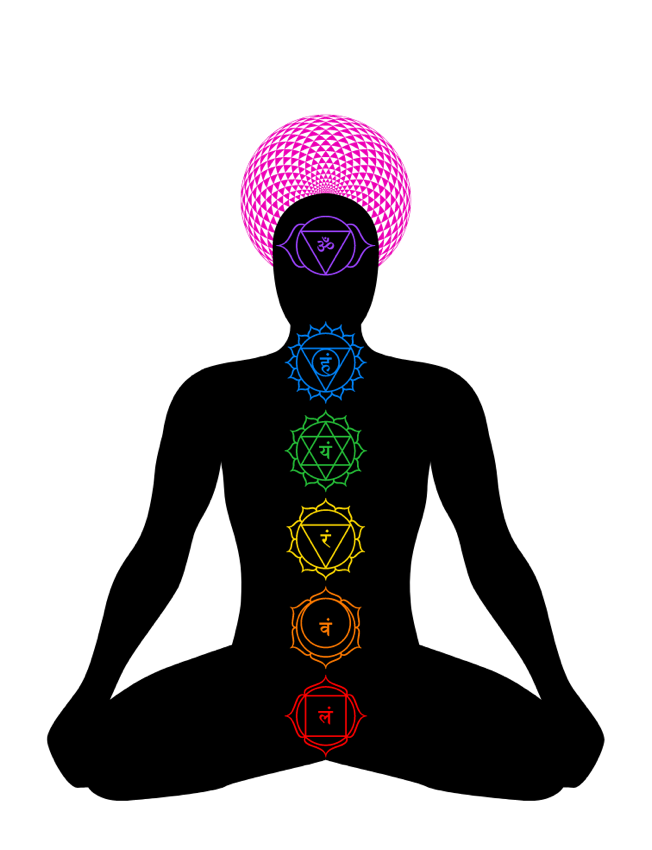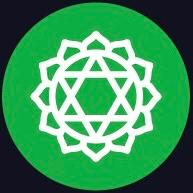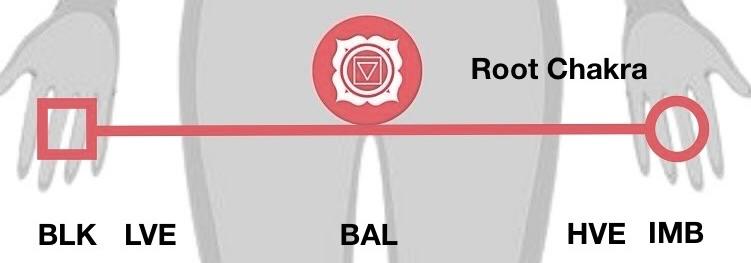All About Chakras

“When all your energies are brought into harmony, your body flourishes. And when your body flourishes, your soul has a soil in which it can blossom in the world. These are the ultimate reasons for energy medicine—to prepare the soil and nurture the blossom.”
— Donna Eden
Chakra FAQ
Chakras are spinning energy centers within our bodies, connecting our physical, mental, and emotional selves. The word “chakra” comes from the Sanskrit language and means “wheel” or “disk.” There are seven main chakras, each corresponding to a specific location in the body, color, and aspect of our lives.
The concept of chakras dates back thousands of years to ancient India, where they were first mentioned in the sacred texts called the Vedas. Over time, chakra teachings evolved and expanded through various spiritual and philosophical traditions, including Hinduism, Buddhism, and Tantra.
When our chakras are balanced and functioning harmoniously, we experience optimal health, happiness, and a strong sense of inner peace. However, when one or more chakras are blocked or misaligned, it can lead to various issues in our physical, emotional, and spiritual well-being. By understanding and working with our chakras, we can bring balance and harmony back into our lives.
The Seven Chakras

- Location: Base of spine
- Responsible for: Stability, security, core needs
- Color: Red
- Element: Earth
- Sound / Affirmation: LAM / I Am
- Gland: Adrenals
The Root Chakra is our foundation and represents stability, security, and basic needs. When balanced, we feel grounded, secure, and connected to the earth. If blocked, we may experience fear, anxiety, and a lack of stability in our lives.
When in Balance:
The root chakra corresponds to the earth element and is associated with planting roots. Therefore, when the root chakra is balanced, you feel grounded, safe, and at ease. However, the root chakra does not just govern physical security. It determines how secure and at home you feel in yourself. So with a balanced first chakra, you’ll be able to do things independently yet have no issues relying or depending on others.
When Unbalanced:
If the root chakra energy is weak, you may feel unstable and unsafe and struggle to feel like you belong. Because it is also linked to financial security, you are more likely to have money worries if your root chakra is unbalanced. People with blocked root chakras typically feel weak, fearful, and insecure. They may struggle to trust others and the world around them and expect bad things to happen.
Healing Practices:
- Grounding: Connect the base of your spine to the earth ("Ass to grass")
- Meditation: Focus your attention on the root chakra point.
- Physical Activity: Walking, barefoot running, and yoga.
- Nutrition: Protein rich foods, root vegetables, and red-colored foods.
- Psychotherapy: Explore the root of your fears
- Aromatherapy: Sandalwood, vetiver, black pepper, and ginger.

- Location: Below the navel
- Responsible for: Regulating emotions, passion, creativity
- Color: Orange
- Element: Navel
- Sound / Affirmation: VAM / I Feel
- Gland: Gonads
The Sacral Chakra governs our emotions, creativity, and desire. When balanced, we experience healthy emotional expression, creativity, and passion. If blocked, we may struggle with emotional imbalance, lack of inspiration, and unhealthy relationships.
When in balance:
People with a balanced sacral chakra can tap into their creative potential and freely express themselves. In addition, they feel emotionally stable with a healthy physical drive and connection to the senses. Someone with a balanced second chakra will feel joy and pleasure from things and experience passion, both romantically and with life pursuits.
When unbalanced:
An unbalanced sacral chakra typically results in the inability to control your emotions. and express yourself. As a result, you may lack self-worth around pleasure and thus, not allow yourself to experience joy in life.
Healing Practices:
- Self-Nurture: Do the things you really enjoy and love.
- Playful Activities: Get creative. Try something new.
- Meditation: Focus your attention on the sacral chakra point.
- Journaling: Write down your feelings and thoughts.
- Nutrition: Create a pleasurable experience with a variety of foods.
- Aromatherapy: Rose, sweet orange, tangerine, and ylang ylang
- Tantra: Enjoy a sexual journey. Find new places on your body that bring you pleasure.

- Location: Above the navel
- Responsible for: Self-esteem, confidence, willpower, inner strength
- Color: Yellow
- Element: Fire
- Sound / Affirmation: RAM / I Do
- Gland: Pancreas
The Solar Plexus is the center of our personal power, self-esteem, and assertiveness. When balanced, we feel confident, capable, and in control of our lives. If blocked, we may experience feelings of low self-worth, powerlessness, and difficulty making decisions.
When in Balance:
A balanced solar plexus gives you the confidence, self-belief, and inner strength to turn your dreams into reality. You will feel courageous with no fear of taking risks, and you’ll be able to pick yourself up after knockbacks and failures. A person with a strong Manipura also has a high level of energy and vitality.
When Unbalanced:
If your Manipura is blocked, you’ll lack confidence and self-belief, resulting in either holding yourself back and staying small or self-sabotaging. You may get ideas and start new projects but fail to follow them through. On a physical level, you’ll likely suffer fatigue and experience issues with digestion, as this chakra is linked to the digestive organs.
On the other hand, if your Manipura chakra is overactive, you may be controlling, power-hungry, self-centered, and competitive. As a result, you’ll likely get angry quickly and experience heartburn or ulcers.
Healing Practices:
- Sunbathing: Get as much sunlight as possible.
- Circadian Rhythm: Adjust your body's "internal clock"
- Meditation: Focus your attention on the solar plexus point.
- Break Routine: Break your routine and try something new.
- Nutrition: Don't overeat. Eat until you are 80% full.
- Aromatherapy: Lemongrass, sandalwood, myrrh, and lavender.
- Physical Activity: Get an extra workout or two in (outdoors, if possible)

- Location: Center of chest
- Responsible for: Relationship with self and others, ability to give and feel love
- Color: Green
- Element: Air
- Sound / Affirmation: YAM / I Love
- Gland: Thymus
The Heart Chakra is the bridge between the lower and higher chakras, governing love, compassion, and forgiveness. When balanced, we experience unconditional love for ourselves and others, empathy, and emotional healing. If blocked, we may struggle with self-love, resentment, and difficulty forming deep connections.
When in Balance:
A person with a balanced heart chakra freely feels and expresses love, joy, and gratitude. They can see their blessings and the beauty around them, and, as a result, they enjoy successful, happy relationships. They can feel empathy towards others and can forgive easily. Moreover, they fully love and accept themselves and can set healthy boundaries, resulting in the sense of harmony within.
When Unbalanced:
Someone with a blocked heart chakra will find it difficult to feel love, compassion, and understanding for others and will find it equally challenging to accept love. In addition, outside of relationships, they will struggle to find things to be grateful for, as they have a tendency to see the bad in people and situations.
The root of a blocked chakra is a lack of self-love and acceptance, as a person cannot give love to others until they can love themselves. Because the Anahata chakra is associated with touch and air (prana), physical symptoms of a blocked heart chakra can be seen in the skin, hands, and lungs.
Healing Practices:
- Breathing: Experiment with different breathing techniques.
- Meditation: Focus your attention on the heart.
- Self-Love: Accept yourself and make healthy choices that benefit your well-being.
- Nutrition: Infuse love into your meals and express gratitude. Make a comfort dish or a loved one's recipe.
- Aromatherapy: Frankincense, geranium, and rose
- Practice Gratitude: Spend time, face to face, with the ones you love.Vocalize your love for them.

- Location: Throat
- Responsible for: Communication
- Color: Light Blue
- Element: Space/Ether
- Sound / Affirmation: HAM / I Speak
- Gland: Thyroid
The Throat Chakra is responsible for communication, self-expression, and truth. When balanced, we can speak and listen with clarity and authenticity. If blocked, we may encounter difficulties expressing ourselves, communicating with others, or standing up for our beliefs.
When in Balance:
If your throat chakra is balanced, you’ll feel confident in public speaking and expressing your ideas and opinions. You’ll be able to clearly articulate your words and speak your truth without holding back. You’ll also be able to listen to others and participate in debates and heated conversations without turning them into arguments.
When Unbalanced:
If there is a blockage in your fifth chakra, you’ll struggle to communicate with others and express yourself fully. Firstly, if the chakra is underactive, you might hold back in speaking your truth and instead say what you think will please others. In addition, you’ll likely detest public speaking and avoid sharing ideas in meetings.
On the other hand, if the chakra is overactive, you might find it challenging to listen to others and tend to gossip. People with overactive throat chakras are more likely to speak over others, shut them down, and not give them space to share their views.
Healing Practices:
- Speak: Talking, mantra chanting, humming, singing and shouting
- Listen: Explore different types of sound healing therapy
- Meditations: Focus your attention on the throat chakra point
- Breathing: Experiment with different breathing techniques
- Journaling: Express your thoughts and emotions
- Aromatherapy: Peppermint, bergamot, basi and geranium

- Location: Between the eyebrows
- Responsible for: Intuition and imagination
- Color: Indigo
- Element: Light
- Sound / Affirmation: OM / I See
- Gland: Pineal (located at top of neck)
The Third-Eye Chakra is the center of intuition, insight, and spiritual wisdom. When balanced, we can access our inner guidance, heightened perception, and psychic abilities. If blocked, we may feel disconnected from our intuition, lack clarity, or struggle with decision-making.
When in Balance:
If your third-eye chakra is open, you’ll be able to see the bigger picture in situations and will make decisions without the egos’ influence. You’ll be able to hear and follow guidance and affirmation from the universe through your intuition and have a strong imagination.
When Unbalanced:
If your third-eye chakra is blocked, you’ll be overly attached to the external world and unable to connect to your inner wisdom. An Ajna chakra blockage can manifest physically as headaches and vision problems. It’s also possible for the third chakra to be overactive. If this happens, you’ll likely be cynical about beliefs different from yours and have trouble accepting reality.
Healing Practices:
- Meditation: Concentrate all of your awareness on the third eye
- Breathing: Deep breaths. Feel the air entering your body through your nose, passing by your third eye and all the way down into your diaphragm.
- Lucid Dreaming: Pay closer attention to your dreams.
- Detox: Massage your pineal glad to release toxins
- Sunlight: Get as much natural light as possible
- Aromatherapy: Patchouli, sandalwood, juniper and vetiver

- Location: Top of the head
- Responsible for: Spiritual connection
- Color: Purple
- Element: Cosmic energy
- Sound / Affirmation: OM / I Know
- Gland: Pituitary
The Crown Chakra connects us to the divine, universal consciousness, and higher states of awareness. When balanced, we experience spiritual enlightenment, unity, and a sense of oneness with all living beings. If blocked, we may feel disconnected from our spiritual selves, lack purpose, or struggle with existential questions.
When in Balance:
People with a balanced crown chakra have a strong spiritual connection to their higher selves. They have fully detached from their ego and external circumstances, and they experience bliss and divine consciousness.
When Unbalanced:
A person with a blockage in the seventh chakra will seek happiness in the external world rather than within. They may also be narrow-minded, stubborn, and even dismiss the existence of spirituality. It is also possible for the crown chakra to become overactive. In this case, a person will lose touch with reality and struggle to function in the physical world.
Healing Practices:
- Meditation: Experiment with different forms of meditation
- Intentional Silence: Limit your speech to the absolute minimum.
- Visualization: Envision a violet-colored lotus at the top of your head
- Energy Work: Tai chi, Qi gong, Reiki, Acupuncture, and Acupressure
- Get Outside: Connect with the world around you
- Aromatherapy: Myrrh, Cedarwood, Jasmine, and Lavender
Your Chakra Map

Your practitioner will assess the energy in each of your chakras using two measurements. These measurements are expressed graphically using a line or spectrum.
First, an assessment is made as to whether the energy in each chakra is visible or not.
If the energy is not visible, an assessment will be made as to whether the energy is blocked (BLK) or imbalanced (IMB).
- Blocked energy (noted on the left end of the spectrum in the box) is generally a sign of trauma and requires deep reflection to awaken the chakras energy. Think of a blocked chakra as a lightbulb that is shut off. Your reflections and healing will turn the lightbulb back on.
- By contrast, Imbalanced energy (noted on the right end of the spectrum in the circle) is generally a sign of disconnection or dissociation with your energy. Using the lightbulb example from above, think of an imbalanced chakra as a door obscuring your view of the light. Is the lightbulb on or off? You won't know until you reconnect. Because of this dissociation (i.e., the closed door), it is possible, upon reconnecting with an imbalanced chakra, you may discover the energy is also blocked (i.e., upon opening the door, you realize the lightbulb is also turned off). Imbalanced energy often requires the greatest amount of work to recover from.
Second, if the energy is visible, meaning the energy in the chakra is neither blocked nor imbalanced, then an assessment as to balance can be made.
The assessment of balance is a spectrum within a spectrum which ranges from Low Vibrational Energy (LVE) to High Vibrational Energy (HVE) with Balanced Energy (BAL) in the middle of that spectrum.
- Low Vibrational Energy signifies a struggle to keep the energy in a chakra balanced and is generally caused by an inability to control the energy or lack of interest in a particular area of your life (i.e., a "broken heart" would be a sign of low vibrational energy in the heart chakra). If the vibrational energy dips too low, it can result in the chakra becoming blocked.
- High Vibrational Energy as well signifies a struggle to keep the energy in a chakra balanced and is generally caused by an overwhelming desire to control the energy in a particular chakra. A person with "a lot on their mind" would be a sign of high vibrational energy in the third eye. If the vibrational energy raises too high, it can result in a chakra becoming imbalanced.
Balance is the Goal! -- A balanced chakra means the energy is visible and is not in danger of becoming blocked or imbalanced due to low or high vibrational energy.
In its simplest form, assessing the health of a chakra is about measuring energy.
To measure the energy in each chakra, your practitioner will place a metal bowl on either your chest or above your head. Then, stones or crystals will be placed on each of your chakras one at a time.
Just as electricity (energy) passes through water differently than rubber, the energy within each of your chakras possesses a unique waveform as it passes through each of the crystals placed upon you. Your practitioner will place their hand over the crystal and "pull" the energy out of each of your chakras. The resulting waveform then manifests itself through sound and vibration that emits from the metal bowl.
Based on the vibrational patterns along with the pitch and intensity emitting from the bowl, your practitioner will be able to assess the health (balance) of each of your chakras.
The information provided on this page and/or by any Method Bodywork practitioner is never intended to be a substitute for professional medical advice, nor is it intended to be a diagnosis of or treatment for any medical or psychological condition. Always consult a physician with any questions you have about your health and before making any changes that may impact your health. This includes, but is not limited to starting, stopping or changing any treatment program, medication regimen, exercise routine, or nutritional plan ordered, implied or suggested by a physician. Method Bodywork and its practitioners make no guarantees or promises regarding the results you will achieve from participating in any program or service offered by Method Bodywork.
